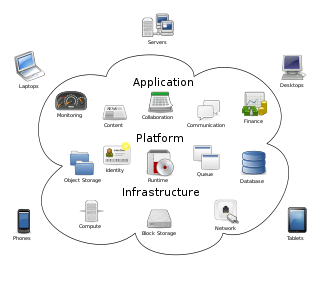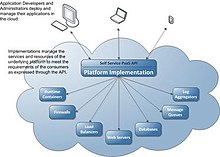The Organization for the Advancement of Structured Information Standards is a nonprofit consortium that works on the development, convergence, and adoption of projects - both open standards and open source - for Computer security, blockchain, Internet of things (IoT), emergency management, cloud computing, legal data exchange, energy, content technologies, and other areas.
Message-oriented middleware (MOM) is software or hardware infrastructure supporting sending and receiving messages between distributed systems. Message-oriented middleware is in contrast to streaming-oriented middleware where data is communicated as a sequence of bytes with no explicit message boundaries. Note that streaming protocols are almost always built above protocols using discrete messages such as frames (Ethernet), datagrams (UDP), packets (IP), cells (ATM), et al.
Web Services for Remote Portlets (WSRP) is an OASIS-approved network protocol standard designed for communications with remote portlets.
Web Services Discovery provides access to software systems over the Internet using standard protocols. In the most basic scenario there is a Web Service Provider that publishes a service and a Web Service Consumer that uses this service. Web Service Discovery is the process of finding suitable web services for a given task.
The Advanced Message Queuing Protocol (AMQP) is an open standard application layer protocol for message-oriented middleware. The defining features of AMQP are message orientation, queuing, routing, reliability and security.
In cryptography, PKCS #11 is a Public-Key Cryptography Standards that defines a C programming interface to create and manipulate cryptographic tokens that may contain secret cryptographic keys. It is often used to communicate with a Hardware Security Module or smart cards.
Digital Signature Services (DSS) is an OASIS standard.
Platform as a service (PaaS) or application platform as a service (aPaaS) or platform-based service is a cloud computing service model where users provision, instantiate, run and manage a modular bundle of a computing platform and applications, without the complexity of building and maintaining the infrastructure associated with developing and launching application(s), and to allow developers to create, develop, and package such software bundles.

The Rackspace Cloud is a set of cloud computing products and services billed on a utility computing basis from the US-based company Rackspace. Offerings include Cloud Storage, virtual private server, load balancers, databases, backup, and monitoring.

Cloud computing is "a paradigm for enabling network access to a scalable and elastic pool of shareable physical or virtual resources with self-service provisioning and administration on-demand," according to ISO.

The Open Cloud Computing Interface (OCCI) is a set of specifications delivered through the Open Grid Forum, for cloud computing service providers. OCCI has a set of implementations that act as proofs of concept. It builds upon World Wide Web fundamentals by using the Representational State Transfer (REST) approach for interacting with services.

FUJITSU Cloud IaaS Trusted Public S5 is a Fujitsu cloud computing platform that aims to deliver standardized enterprise-class public cloud services globally. It offers Infrastructure-as-a-Service (IaaS) from Fujitsu's data centres to provide computing resources that can be employed on-demand and suited to customers needs.
JumpSoft Inc is an American software company that provides application performance management (APM) software. JumpSoft is a committee member for several industry web services standards including web services interoperability and cloud application management for platforms. In 2012 JumpSoft co-proposed a new industry web services standard for managing cloud applications on PaaS environments called CAMP.
Cloud Infrastructure Management Interface (CIMI) is an open standard API specification for managing cloud infrastructure.
Topology and Orchestration Specification for Cloud Applications (TOSCA) is an OASIS standard language to describe a topology of cloud based web services, their components, relationships, and the processes that manage them. The TOSCA standard includes specifications of a file archive format called CSAR.
Cloud management is the management of cloud computing products and services.
"X as a service" is a phrasal template for any business model in which a product use is offered as a subscription-based service rather than as an artifact owned and maintained by the customer. Originating from the software as a service concept that appeared in the 2010s with the advent of cloud computing, the template has expanded to numerous offerings in the field of information technology and beyond it. The term XaaS can mean "anything as a service".
Content as a service (CaaS) or managed content as a service (MCaaS) is a service-oriented model, where the service provider delivers the content on demand to the service consumer via web services that are licensed under subscription. The content is hosted by the service provider centrally in the cloud and offered to a number of consumers that need the content delivered into any applications or system, hence content can be demanded by the consumers as and when required.

Oracle Cloud is a cloud computing service offered by Oracle Corporation providing servers, storage, network, applications and services through a global network of Oracle Corporation managed data centers. The company allows these services to be provisioned on demand over the Internet.





